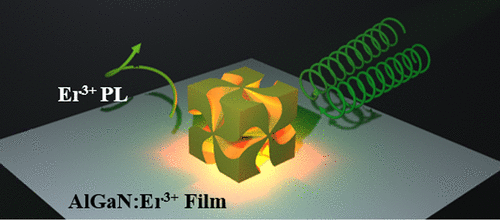Our official English website, www.x-mol.net, welcomes your
feedback! (Note: you will need to create a separate account there.)
Experimental and Theoretical Observation of Photothermal Chirality in Gold Nanoparticle Helicoids.
ACS Nano ( IF 15.8 ) Pub Date : 2020-03-16 , DOI: 10.1021/acsnano.9b09062 Ali Rafiei Miandashti 1 , Larousse Khosravi Khorashad 2 , Martin E Kordesch 2 , Alexander O Govorov 2, 3 , Hugh H Richardson 1
ACS Nano ( IF 15.8 ) Pub Date : 2020-03-16 , DOI: 10.1021/acsnano.9b09062 Ali Rafiei Miandashti 1 , Larousse Khosravi Khorashad 2 , Martin E Kordesch 2 , Alexander O Govorov 2, 3 , Hugh H Richardson 1
Affiliation

|
Single-particle spectroscopy is central to the characterization of plasmonic nanostructures and understanding of light-matter interactions in chiral nanosystems. Although chiral plasmonic nanostructures are generally characterized by their circular differential extinction and scattering, single-particle absorption studies can extend our understanding of light-matter interactions. Here, we introduce an experimental observation of photothermal chirality which originated from circular differential absorption of chiral plasmonic nanostructures. Using luminescence ratio thermometry, we identify the optical and photothermal handedness and an absolute temperature difference of 6 K under the right and left circularly polarized light. We observe a circular differential extinction parameter (gext) of -0.13 in colloidally prepared gold helicoids and compare our findings with numerical simulations using finite element methods. The simulated data showed that circular differential absorption and the maximum temperature of a small cluster of helical nanoparticles are polarization-dependent. We observed an intensity-dependent photothermal g-factor from chiral helicoids that decreases slightly at higher temperatures. We also measure a range of optical g-factors from several gold helicoids, which are attributed to the heterogeneity of helicoids in nanoparticles during synthesis. The principles of differential photothermal response of chiral nanomaterials and heat generation described here can be potentially used for thermal photocatalysis, energy conversion, and electronic applications.
中文翻译:

金纳米颗粒螺旋体光热手性的实验和理论观察。
单粒子光谱法是表征等离激元纳米结构和理解手性纳米系统中光与物质相互作用的关键。尽管手性等离子体纳米结构通常以其圆形微分消光和散射为特征,但是单粒子吸收研究可以扩展我们对光-质相互作用的理解。在这里,我们介绍了光热手性的实验观察,它来自手性等离子体纳米结构的圆形差分吸收。使用发光比测温法,我们确定了在右旋和左旋圆偏振光下的光学和光热惯用性以及6 K的绝对温度差。我们观察到圆形微分消光参数(gext)为-0。胶体制备的13个金螺旋形化合物,并将我们的发现与使用有限元方法进行的数值模拟进行比较。仿真数据表明,圆形微分吸收和一小团螺旋纳米颗粒的最高温度与偏振有关。我们观察到来自手性螺旋体的强度依赖性光热g因子在较高温度下略有下降。我们还测量了几种金螺旋分子的光学g因子范围,这归因于合成过程中纳米颗粒中螺旋体的异质性。本文描述的手性纳米材料与热产生的差异光热响应原理可潜在地用于热光催化,能量转换和电子应用。仿真数据表明,圆形微分吸收和一小团螺旋纳米颗粒的最高温度与偏振有关。我们观察到来自手性螺旋体的强度依赖性光热g因子在较高温度下略有下降。我们还测量了几种金螺旋分子的光学g因子范围,这归因于合成过程中纳米颗粒中螺旋体的异质性。本文描述的手性纳米材料与热产生的差异光热响应原理可潜在地用于热光催化,能量转换和电子应用。模拟数据表明,圆形微分吸收和一小团螺旋纳米颗粒的最高温度与偏振有关。我们观察到来自手性螺旋体的强度依赖性光热g因子在较高温度下略有下降。我们还测量了几种金螺旋分子的光学g因子范围,这归因于合成过程中纳米颗粒中螺旋体的异质性。本文描述的手性纳米材料与热产生的差异光热响应原理可潜在地用于热光催化,能量转换和电子应用。我们观察到来自手性螺旋体的强度依赖性光热g因子在较高温度下略有下降。我们还测量了几种金螺旋分子的光学g因子范围,这归因于合成过程中纳米颗粒中螺旋体的异质性。本文描述的手性纳米材料与热产生的差异光热响应原理可潜在地用于热光催化,能量转换和电子应用。我们观察到来自手性螺旋体的强度依赖性光热g因子在较高温度下略有下降。我们还测量了几种金螺旋分子的光学g因子范围,这归因于合成过程中纳米颗粒中螺旋体的异质性。本文描述的手性纳米材料与热产生的差异光热响应原理可潜在地用于热光催化,能量转换和电子应用。
更新日期:2020-03-16
中文翻译:

金纳米颗粒螺旋体光热手性的实验和理论观察。
单粒子光谱法是表征等离激元纳米结构和理解手性纳米系统中光与物质相互作用的关键。尽管手性等离子体纳米结构通常以其圆形微分消光和散射为特征,但是单粒子吸收研究可以扩展我们对光-质相互作用的理解。在这里,我们介绍了光热手性的实验观察,它来自手性等离子体纳米结构的圆形差分吸收。使用发光比测温法,我们确定了在右旋和左旋圆偏振光下的光学和光热惯用性以及6 K的绝对温度差。我们观察到圆形微分消光参数(gext)为-0。胶体制备的13个金螺旋形化合物,并将我们的发现与使用有限元方法进行的数值模拟进行比较。仿真数据表明,圆形微分吸收和一小团螺旋纳米颗粒的最高温度与偏振有关。我们观察到来自手性螺旋体的强度依赖性光热g因子在较高温度下略有下降。我们还测量了几种金螺旋分子的光学g因子范围,这归因于合成过程中纳米颗粒中螺旋体的异质性。本文描述的手性纳米材料与热产生的差异光热响应原理可潜在地用于热光催化,能量转换和电子应用。仿真数据表明,圆形微分吸收和一小团螺旋纳米颗粒的最高温度与偏振有关。我们观察到来自手性螺旋体的强度依赖性光热g因子在较高温度下略有下降。我们还测量了几种金螺旋分子的光学g因子范围,这归因于合成过程中纳米颗粒中螺旋体的异质性。本文描述的手性纳米材料与热产生的差异光热响应原理可潜在地用于热光催化,能量转换和电子应用。模拟数据表明,圆形微分吸收和一小团螺旋纳米颗粒的最高温度与偏振有关。我们观察到来自手性螺旋体的强度依赖性光热g因子在较高温度下略有下降。我们还测量了几种金螺旋分子的光学g因子范围,这归因于合成过程中纳米颗粒中螺旋体的异质性。本文描述的手性纳米材料与热产生的差异光热响应原理可潜在地用于热光催化,能量转换和电子应用。我们观察到来自手性螺旋体的强度依赖性光热g因子在较高温度下略有下降。我们还测量了几种金螺旋分子的光学g因子范围,这归因于合成过程中纳米颗粒中螺旋体的异质性。本文描述的手性纳米材料与热产生的差异光热响应原理可潜在地用于热光催化,能量转换和电子应用。我们观察到来自手性螺旋体的强度依赖性光热g因子在较高温度下略有下降。我们还测量了几种金螺旋分子的光学g因子范围,这归因于合成过程中纳米颗粒中螺旋体的异质性。本文描述的手性纳米材料与热产生的差异光热响应原理可潜在地用于热光催化,能量转换和电子应用。









































 京公网安备 11010802027423号
京公网安备 11010802027423号